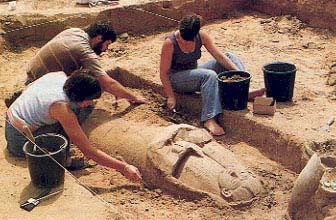Image Details

Zev Radovan, courtesy National Geographic Society
Unburying the past. Three excavators gingerly expose an anthropoid coffin at Deir el-Balah, south of Gaza. This coffin’s face and hands are formed in what archaeologist Trude Dothan has termed the “naturalistic” type. The rivulet-like indentations around the head and on the chest represent an Egyptian-style headdress. The grave in which this coffin lies is about 10 feet long, 5.5 feet wide and 5.5 feet below the original surface. The coffin was found filled with sand that had seeped through cracks over the centuries; the sand helped keep intact most of the coffin’s walls even though cracked.
The Egyptian practice of burial in anthropoid coffins spread to Canaan in the 14th century B.C. with Egyptian expansion into the area. Anthropoid coffins have been found primarily in administrative and military centers and in road stations, such as Deir el-Balah, along the route from Sinai.
